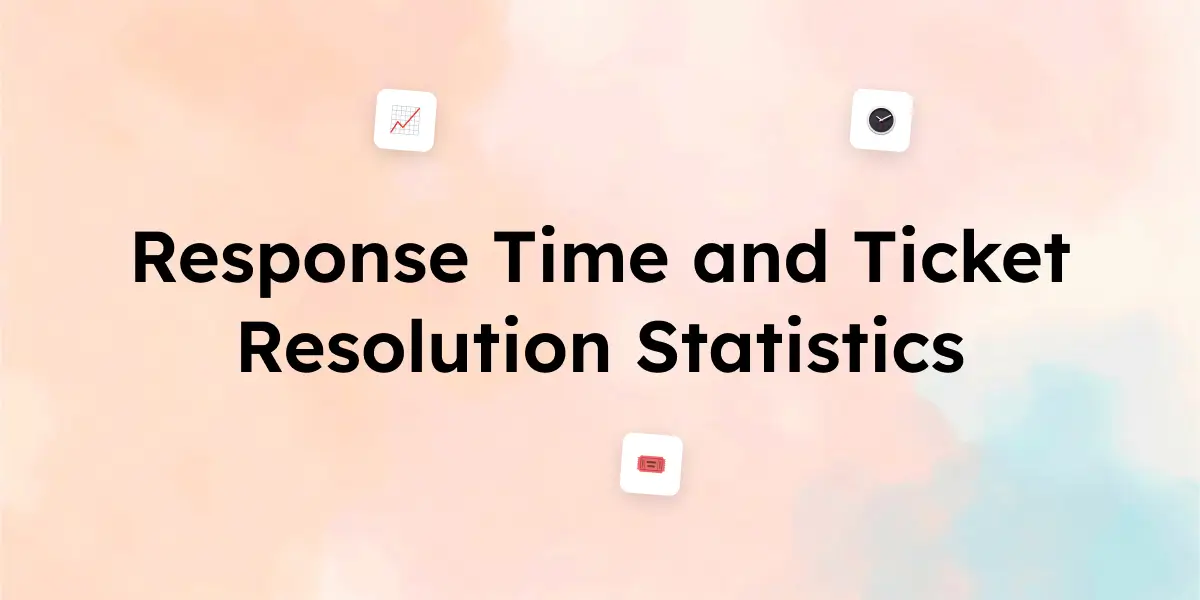Today, fast response times and efficient ticket resolution are critical to customer satisfaction, loyalty, and business growth. Whether through live chat, email, or AI-powered support, businesses must meet rising consumer expectations for instant and effective customer service.
This report highlights 40+ key statistics on response times, ticket resolution, automation, and industry benchmarks for 2025. We’ll explore emerging trends, AI-driven improvements, and best practices to help businesses optimize their customer support strategies.
40+ Response Time and Ticket Resolution Statistics
🚀 General Customer Support & Help Desk Stats
- 88% of customers expect a response to their inquiry within 60 minutes.
- The average first response time (FRT) across industries is 12 hours, but top performers respond within 1 hour.
- 79% of customers say fast response time is the most important aspect of customer experience .
- 73% of consumers are more likely to stay loyal to brands with quick and effective support .
- Companies with 24/7 live chat resolve issues 3x faster than those using only email or phone support.
- 55% of customers expect businesses to use AI/chatbots for instant responses.
- 65% of businesses plan to invest more in automated ticketing systems by 2025.
⏳ Response Time Benchmarks by Channel (2025 Projections)
- Live chat: Average response time is 45 seconds; ideal time is under 30 seconds.
- Social media: 60% of customers expect a response within 1 hour, but the average response time is 4 hours.
- Email support: Standard response time is 12-24 hours, but top companies reply in under 6 hours.
- Phone support: 80% of calls should be answered within 20 seconds.
- AI chatbots resolve 30% of tickets instantly, reducing human agent workload.
🛠️ Ticket Resolution Time & Efficiency
- Average ticket resolution time: 8-24 hours, but complex cases take 3+ days.
- First contact resolution (FCR) rate: Industry benchmark is 70-75%.
- Best-performing teams resolve tickets in under 6 hours.
- SLA compliance rate: 85-90% of businesses aim to resolve tickets within SLA-defined timeframes.
- AI-driven ticketing systems reduce resolution time by 40%.
- Multichannel support teams resolve 25% more tickets per hour than single-channel teams.
🏆 Industry-Specific Response & Resolution Trends
- E-commerce: 90% of inquiries demand responses within 30 minutes.
- B2B SaaS: Average response time is 3 hours, with a resolution time of 15 hours.
- Healthcare: 70% of patients expect a response to inquiries within 4 hours.
- Finance & Banking: 50% of customers expect responses in under 10 minutes.
📈 Impact of AI & Automation on Response Time
- AI-powered chatbots handle 80% of routine queries, cutting human workload by 30%.
- AI-driven ticket classification reduces response time by 50%.
- Automated workflows improve SLA compliance by 35%.
- AI integration in ticketing systems leads to 98% accuracy in ticket prioritization.
- Companies using AI see a 2x increase in customer satisfaction scores.
⚡ Productivity & Agent Performance Metrics
- Average tickets per agent per day: 20-40, depending on complexity.
- Top-performing agents resolve 50+ tickets daily with AI support.
- Agent utilization rate: Ideal benchmark is 85% for high-efficiency teams.
- Customer support teams using automation reduce workload by 20-40%.
- High-resolution efficiency teams close 80% of tickets within 24 hours.
🔍 Customer Satisfaction & Retention
- 86% of customers will pay more for faster support.
- Companies with response times under 5 minutes have 4x higher customer retention rates.
- Slow response times are the #1 reason for customer churn.
- 87% of customers expect businesses to proactively update them on ticket status.
- 90% of companies now track CSAT (Customer Satisfaction Score) for ticket handling.
- Businesses that reduce response time by 50% see a 20% increase in revenue.
- Companies prioritizing customer service outperform competitors by 60% in revenue growth.
🚀 Future Trends & Predictions for 2025
- AI-driven support will handle 50%+ of all customer service interactions.
- Businesses that implement real-time customer support analytics will increase efficiency by 30%.
- Voice AI bots will handle 25% of call center queries, improving resolution time.
- Personalized customer service will become a key differentiator in competitive markets.
- Instant messaging apps (WhatsApp, Messenger, WeChat) will overtake email as the primary support channel.
Conclusion
As we move into 2025, speed, automation, and personalization are shaping the future of customer support. AI-driven chatbots, automated ticketing systems, and multichannel support are no longer optional—they are essential. Companies that reduce response times, optimize agent performance, and leverage AI will gain a competitive edge, boost customer satisfaction, and increase retention rates.
To stay ahead, businesses should:
✅ Invest in AI-powered customer support for faster resolutions.
✅ Optimize multichannel response strategies (live chat, email, social media, phone).
✅ Monitor key metrics (First Response Time, Ticket Resolution Time, FCR, CSAT).
✅ Use real-time analytics to continuously improve support efficiency.
By prioritizing fast, efficient, and proactive support, companies can outperform competitors, increase revenue, and create lasting customer relationships in 2025 and beyond.
Frequently Asked Questions
1. What is a good average response time for customer support in 2025?
A good response time depends on the support channel:
Live chat: Under 30 seconds
Phone support: Within 20 seconds
Email: Under 6 hours (standard is 12-24 hours)
Social media: Within 1 hour
Top-performing companies aim to respond within minutes for all inquiries.
2. What is the industry benchmark for ticket resolution time?
The average ticket resolution time across industries is 8-24 hours, with complex cases taking up to 3 days. Leading support teams resolve most tickets within 6 hours.
3. How does AI impact response and resolution times?
AI-powered customer support can:
Reduce response times by 50% through chatbots and automated workflows.
Resolve 30% of tickets instantly without human intervention.
Improve SLA compliance by 35% using AI-driven ticket routing.
4. What is First Contact Resolution (FCR), and why is it important?
FCR measures the percentage of tickets resolved on the first interaction without requiring follow-ups. A high FCR (70-75% is ideal) means:
Faster issue resolution
Better customer satisfaction (CSAT)
Lower support costs
5. How can businesses improve response time and ticket resolution?
To optimize response and resolution times, companies should:
✅ Use AI chatbots and automation to handle routine queries.
✅ Implement omnichannel support (live chat, email, social media, phone).
✅ Monitor key performance metrics (FRT, FCR, CSAT, resolution time).
✅ Provide agent training and improve workflow efficiency.
📌 Sources & References :
The following sources were used to compile these statistics:
- Zendesk Customer Experience Trends 2024-2025
- Salesforce State of Service Report 2024
- Forrester Customer Service Benchmark Report
- Gartner AI in Customer Service Predictions 2025
- Freshdesk 2024 Customer Support Trends Report
- LiveChat Inc. 2024 Customer Service Benchmark Report
- Statista Customer Support Response Time Data 2024-2025



